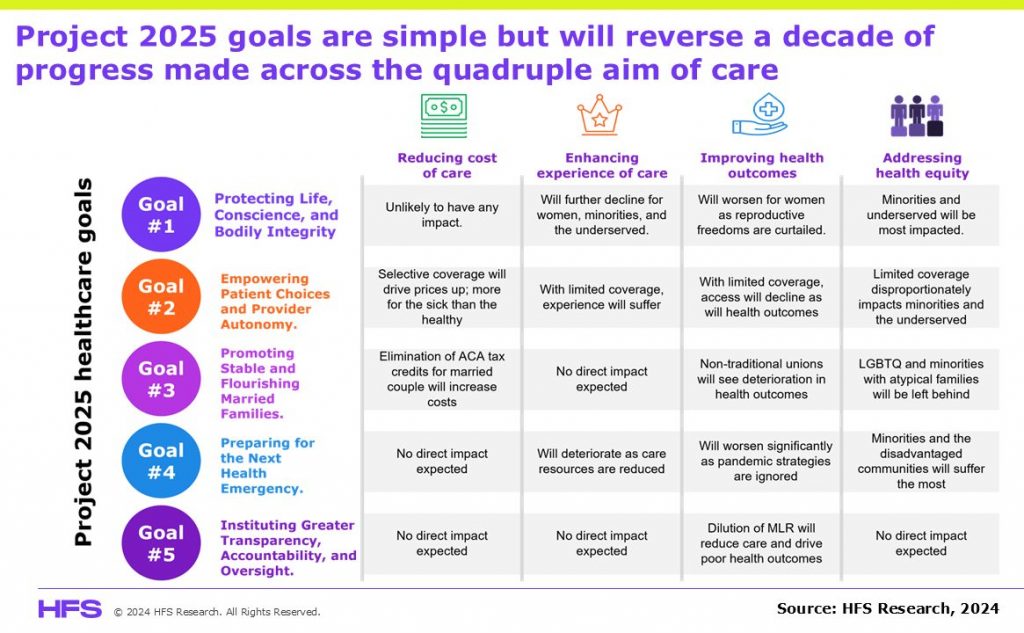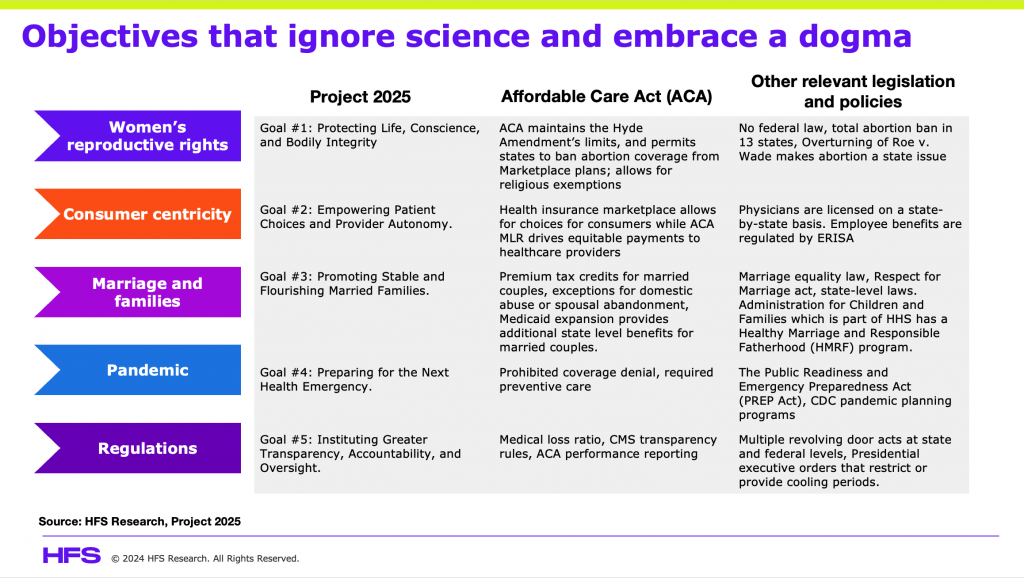We are hurtling towards a US presidential election in which only a small proportion of people are fully aware of the consequences, whether it be the economy, immigration, healthcare, education, the climate emergency, and so on. While Kamala Harris has been specific regarding her policies, we need to examine Project 2025 to understand where policies are likely to be set under the Republican administration.
What concerns me a great deal is the proposed removal of the Patient Protection and Affordable Care Act (ACA)—previously called Obamacare—by the Heritage Foundation that we fully anticipate this Republican administration to execute, especially after President Trump’s determined -(but failed) attempts to repeal the ACA during his previous term. Essentially, when we remove the ACA, we will reverse history back to before 2010, when citizens could be refused insurance coverage for a pre-existing/chronic condition, which today impacts six out of ten citizens, according to the CDC. This will have a huge impact on both citizens and their employers as so many people struggle to access the urgent care they need.
HFS’ lead healthcare analyst, Rohan Kulkarni, has endured the US healthcare system for 16 years as a CIO, strategist, consultant, market maker, and now an analyst who has delved deep into the consequences of Project 2025 on US healthcare to understand what to expect. Over to you, Rohan…
The US presidential elections could reshape healthcare across the quad-aim of care
Elections always have consequences; this one in 2024 will impact life and death, particularly for certain population demographics. The choice in the 2024 election is between improving the Patient Protection and Affordable Care Act (ACA), the law of the land, or significantly diluting it with Project 2025, the conservative agenda published by the Heritage Foundation. The exhibit below reflects Project 2025’s healthcare goals and its impacts on the quadruple aim of care (reducing the cost of care, enhancing the experience of care, improving health outcomes, and addressing health equities), which will reverse the progress made over the last decade relative to the cost of care ($0 premium Medicare Advantage, exchange plans), health equity, access to care (lowest uninsured levels ever), and even health outcomes in some limited contexts.
The healthcare-related goals of Project 2025 are intrinsically regressive
Project 2025 lists five goals for the US Department of Health and Human Services (HHS), as shown in Exhibit 2, that form the foundation of a new healthcare paradigm. These goals are a mix of non-healthcare aspirations, such as marriage, and non-scientific assertions like “abortion” and “euthanasia” are not healthcare. The goals are framed to transform US healthcare without the need for Congressional action, rather through the executive actions of the Secretary of HHS.
The first goal aims to ban abortion federally and ignores transgender realities, diminishing equity in healthcare. In meeting the first goal, project 2025 will drive poor health outcomes by ignoring underserved communities that often need the most help. In particular, a federal abortion ban that leaks into other women’s health affairs will curtail access to care as obstetrics and gynecologists quit the field, as we see in many states that have banned abortion.
The second goal is to empower patient choices and provider autonomy, which are already part of the healthcare system. The ACA marketplaces allow consumers to shop and buy health insurance based on their needs, from bronze plans with high deductibles to silver with moderate deductibles to gold and platinum with low deductibles, plans for everyone’s affordability and health needs. ACA provides government subsidies to buy the plans based on income levels. Project 2025 seeks a paradigm that existed prior to ACA, where health insurers could decline to cover consumers and use pre-existing to deny care. As part of the ACA plan selection, consumers, based on their location, can choose from a significant number of providers across specializations. A central tenet of good care delivery is the patient-provider interaction without outside interference, which is generally true in the current context.
The third goal warrants HHS to minimize and possibly ignore same-sex marriages and the needs of LGBTQ+ by emphasizing traditional marriages between a man and woman. While those go against existing laws that the Supreme Court has upheld, there is no empirical evidence to show same-sex marriages yield in families that are any less productive, happy, or have a negative bearing on our society. Project 2025 not only designs a path to return to times of expensive healthcare with poorer health outcomes but attempts to transform society by biasing its plans towards certain demographics.
Goal number four seeks to abandon public health strategies to mitigate pandemics, such as forced lockdowns, isolations, and vaccine mandates. Project 2025 asserts that these techniques with COVID-19 led to distrust in the health agencies and more unnecessary deaths. However, there is significant evidence that those techniques worked, here in the US and overseas, to prevent the spread of disease and reduce deaths. A state-by-state review of COVID-19 deaths shows an increase in per capita deaths in states that refused to follow locked-down and isolation protocols, delayed the delivery of vaccines, and mismanaged communications.
The last published goal intends to reduce the influence of pharmaceutical and healthcare enterprises over the functioning of agencies. It seeks to eliminate the revolving door between government and the private sector. While that is laudable, Project 2025 does not address where expertise will come from to help progress the government’s understanding of science to inform policy. It further goes on to indicate the need for a new set of metrics to determine the extent to which HHS policies and programs achieve desired health and welfare outcomes, something that is already in place with significant checks and balances.
The Bottom Line: Project 2025 seeks to kill the ACA and remake US healthcare through HHS and without legislative action.
Political noise leading up to any election can make the future fuzzier than it is. However, Project 2025 provides a blueprint of how healthcare will be remodeled. Project 2025 proposals suggest a regressive impact on the quadruple aim of care, setting America back to a healthcare paradigm before the enactment of the ACA in 2010 when selective coverage or denial of care for pre-existing conditions was the standard. It is essential that employers remain true to the health and care needs of their employees, adjusting their strategies under a drastically different regulatory framework.
Posted in : Employee Experience, Healthcare, Politics







